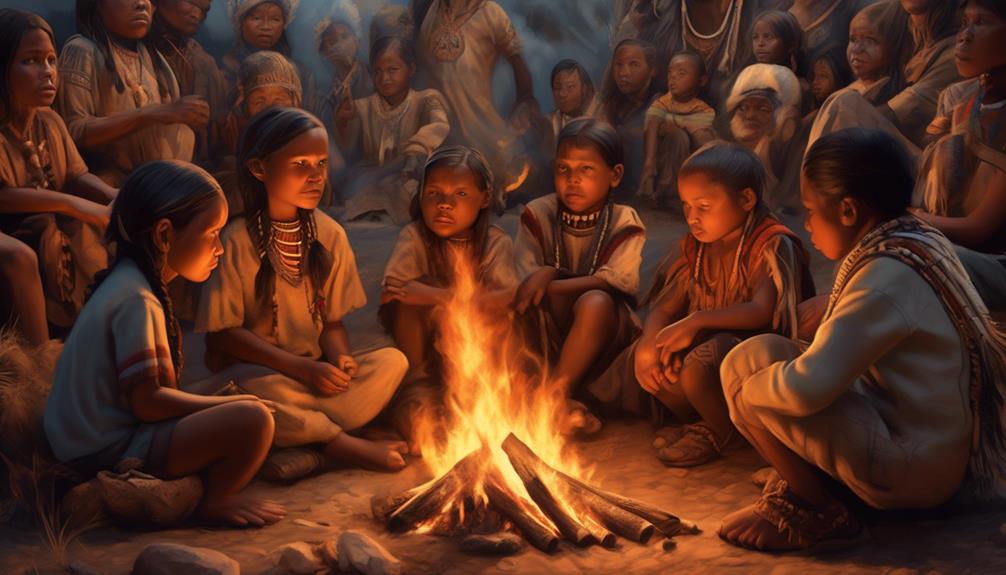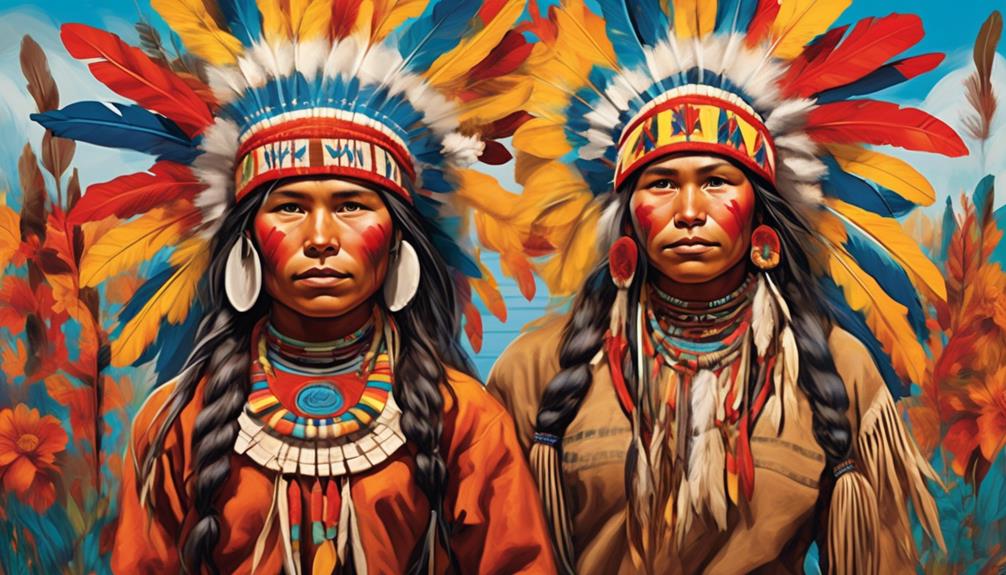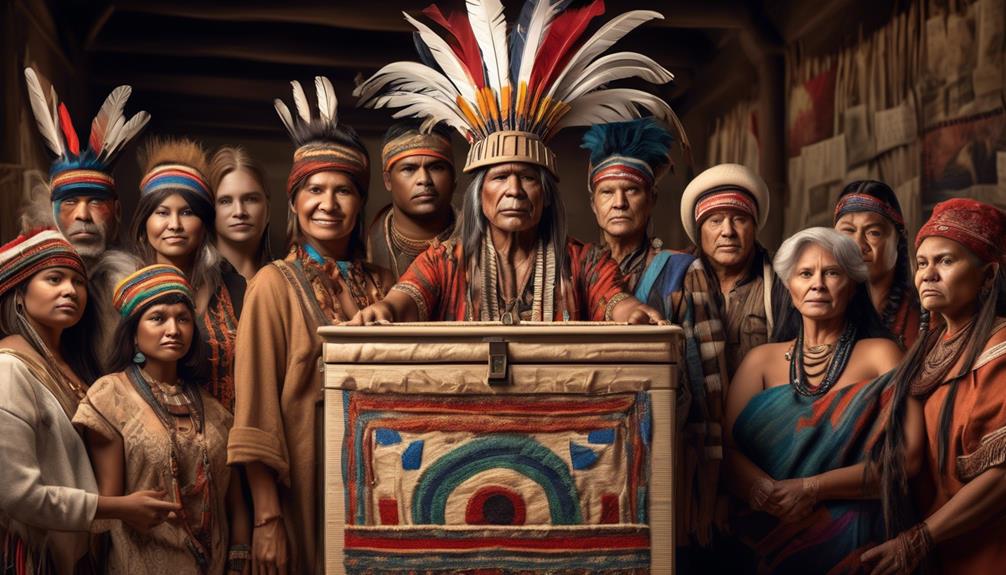As we journey through the complex tapestry of history, we often encounter the resilient spirit of indigenous communities who steadfastly resisted assimilation. The ways in which these groups worked to preserve their cultural heritage and customs are both motivating and thought-provoking.
From the rugged landscapes of armed resistance to the intricate weaving of cultural revitalization, the methods employed by indigenous populations reflect a deep-rooted determination to safeguard their heritage.
But what specific actions did they take to resist the powerful forces of assimilation? Let's explore the multifaceted strategies employed by these communities in their unwavering quest for autonomy and preservation.
Key Takeaways
- Indigenous communities engaged in armed resistance as a last resort to protect their sovereignty and cultural identity.
- Cultural revitalization initiatives were undertaken to reclaim and preserve traditions, language, and ancestral knowledge.
- Legal battles have been pivotal in the struggle for Indigenous rights and autonomy, addressing issues such as land rights, resource management, cultural protection, and self-governance.
- Engaging with political institutions and advocating for Indigenous rights is crucial for autonomy and challenging oppression.
Armed Resistance
Indigenous communities have historically engaged in armed resistance as a means to protect their sovereignty and cultural identity from the encroachment of assimilationist forces. This form of resistance was often a last resort, employed when all other avenues of preserving their ways of life were exhausted. The decision to take up arms wasn't taken lightly, as it carried immense risks and often led to devastating consequences. However, it was a testament to the unwavering determination of these communities to safeguard their autonomy and cultural heritage.
Armed resistance was also a powerful manifestation of community solidarity. It brought people together, uniting them in the face of adversity and creating a shared sense of purpose. The act of standing up against oppressive forces fostered a deep bond among community members, strengthening their resolve and resilience. It was a demonstration of collective agency, where individuals banded together to defend their way of life, drawing strength from their shared history and interconnectedness.
In examining armed resistance, it becomes evident that it wasn't just a physical struggle, but also a deeply emotional and spiritual one. It embodied the profound connection that Indigenous communities have with their land, traditions, and ancestors. It's a testament to the enduring spirit and unwavering commitment of these communities to uphold their inherent rights and cultural autonomy.
Cultural Revitalization

Cultural revitalization initiatives have become a vital means for Indigenous communities to reclaim and preserve their traditions, language, and ancestral knowledge amidst the ongoing challenges of assimilation and cultural erosion.
Language preservation is at the core of these efforts, as language isn't only a means of communication but also a repository of traditional knowledge, cultural practices, and worldview. Through language revitalization programs, Indigenous communities are actively working to ensure that their native languages are passed down to future generations, thereby safeguarding their cultural identity.
Traditional practices, such as ceremonies, rituals, and artistic expressions, play a crucial role in cultural revitalization as well. By engaging in these practices, Indigenous communities aren't only preserving their heritage but also fostering a sense of belonging and pride among their members.
Furthermore, these initiatives also serve as a form of resistance against the erasure of Indigenous cultures, offering a pathway for cultural resilience and empowerment. Cultural revitalization isn't just about preserving the past; it's about creating a sustainable future where Indigenous traditions continue to thrive.
Legal Battles
Legal battles have been a contentious and enduring aspect of the struggle for Indigenous rights and autonomy, representing a complex intersection of historical grievances, sovereign claims, and contemporary legal frameworks. In the face of legislative resistance and courtroom confrontations, Indigenous communities have sought to assert their rights and challenge assimilationist policies. These legal battles have been pivotal in shaping the course of Indigenous resistance, often highlighting the tension between traditional governance systems and imposed colonial laws.
Courtroom confrontations have become a platform for Indigenous communities to challenge discriminatory policies and assert their inherent rights. From land rights and resource management to cultural protection and self-governance, legal battles have been instrumental in addressing historical injustices and asserting sovereignty. The resilience and determination displayed in these legal battles underscore the deep-rooted commitment of Indigenous peoples to uphold their autonomy and cultural integrity.
Despite the formidable challenges posed by legislative resistance, Indigenous communities have persistently utilized legal avenues to contest assimilationist policies and advance their rights. These legal battles, fraught with complexities and historical context, continue to shape the landscape of Indigenous rights and autonomy, offering a glimpse into the enduring struggle for justice and self-determination.
Educational Empowerment

A comprehensive and equitable educational system is fundamental to the empowerment and self-determination of Indigenous communities, providing the necessary tools for cultural preservation and socioeconomic advancement.
Empowerment through education allows Indigenous populations to reclaim their narratives, revitalize traditional knowledge, and counteract the erasure of their histories.
Language preservation is a crucial aspect of educational empowerment, as it enables the transmission of cultural values, traditions, and ways of knowing. By incorporating Indigenous languages into the educational curriculum, communities can ensure the continuity of their linguistic heritage, fostering a sense of pride and identity among younger generations.
Moreover, educational empowerment equips Indigenous individuals with the skills and knowledge needed to engage in advocacy, policy-making, and leadership roles within their communities and beyond. It also serves as a means to challenge stereotypes, dismantle systemic barriers, and promote Indigenous representation in various fields.
However, it's essential to recognize that educational empowerment must be approached in a culturally sensitive and community-driven manner, respecting Indigenous ways of knowing and learning.
Ultimately, by prioritizing empowerment through education and language preservation, Indigenous communities can assert their sovereignty and shape their own destinies.
Political Advocacy
Engaging with political institutions and advocating for Indigenous rights is a critical aspect of asserting our autonomy and challenging systemic oppression. Lobbying efforts and grassroots activism have been key strategies in amplifying our voices and pushing for policy changes that respect our sovereignty and cultural heritage.
Through lobbying, we engage directly with lawmakers and government bodies to influence decision-making processes. This involves building relationships, presenting evidence-based arguments, and promoting legislation that aligns with our needs and aspirations.
Grassroots activism, on the other hand, empowers our communities to mobilize from the ground up, raising awareness, organizing demonstrations, and creating platforms for our voices to be heard. It serves as a powerful tool for building solidarity, fostering community resilience, and creating momentum for change. By harnessing the collective power of our communities, grassroots activism has the potential to drive meaningful societal transformation.
These forms of political advocacy are vital in challenging the historical marginalization of Indigenous peoples and reshaping the narrative around our rights and identities. By actively participating in the political sphere, we strive to dismantle oppressive structures and create a more inclusive and equitable society.
Frequently Asked Questions
How Did the Indigenous Populations Adapt Their Traditional Cultural Practices to Resist Assimilation?
In considering cultural adaptation and resistance through art, indigenous populations utilized various strategies to maintain their traditional cultural practices in the face of assimilation.
By harnessing the power of art, storytelling, and cultural expression, they were able to assert their identity and resist external pressures to conform.
These acts of resilience and creativity served as powerful tools in preserving their heritage and challenging the forces of assimilation.
What Specific Legal Strategies Did Indigenous Populations Use to Protect Their Land Rights and Resources?
Legal strategies used by indigenous populations to protect their land rights and resources included litigation, lobbying, and treaty negotiations. These approaches empowered us to assert our sovereignty and assert control over our ancestral lands.
Our cultural adaptation and resilience played a crucial role in these legal battles, demonstrating our commitment to preserving our traditions and heritage. Through these strategies, we fought for our rights and advocated for the future of our youth.
How Did Indigenous Communities Work to Create Their Own Educational Institutions and Curriculum to Empower Their Youth?
Empowerment through education allows Indigenous youth to assert their cultural identity and resist assimilation. Our communities established their own educational institutions and developed curricula that celebrated our traditions and histories. By doing so, we reclaimed control over the knowledge passed on to future generations, fostering resilience and pride in our heritage.
This act of resistance through education strengthens our cultural fabric and empowers our youth to navigate the complexities of the modern world while honoring their roots.
What Were Some of the Key Political Advocacy Efforts Led by Indigenous Populations to Resist Assimilation?
In our journey towards preserving our cultural identity, political activism has been our guiding star. We've fiercely advocated for our rights and pushed for policies that respect our traditions.
Our resilience in the face of assimilation has been a testament to our commitment to cultural adaptation while maintaining our unique heritage.
Through strategic advocacy efforts, we've strived to protect our way of life, ensuring that future generations can inherit the richness of our indigenous traditions.
How Did Indigenous Populations Use Art and Creativity as a Form of Resistance Against Assimilation?
Using art as a form of resistance, Indigenous populations expressed their cultural resilience and fought against assimilation.
Through artistic resistance, they reclaimed their traditions, language, and identity, resisting efforts to erase their culture.
Art became a powerful tool for cultural adaptation, enabling Indigenous communities to preserve their heritage and pass it on to future generations.
This creative resistance played a crucial role in maintaining their unique cultural identities in the face of assimilation pressures.
Conclusion
In the face of forced assimilation, some indigenous populations resisted through armed resistance, cultural revitalization, legal battles, educational empowerment, and political advocacy.
It's ironic that the very systems meant to erase their identity only fueled their determination to preserve it. Through resilience and perseverance, they fought back against cultural erasure, reclaiming their heritage and carving out a space for themselves in a world that sought to erase them.
Mary is a passionate writer who brings creativity and a fresh perspective to our team. Her words have the power to captivate and inspire, making her an essential contributor to our content. Mary’s commitment to storytelling and dedication to promoting Indigenous culture ensures that her work touches the hearts of our readers. We’re fortunate to have her as part of our team.










